#Indus Valley Script
Explore tagged Tumblr posts
Text
Anyone who can decode 5,000-year-old stone slab can get £800,000
Do you think you can work out what’s on these ancient seals? If you can prove it, you could be in line for a whopping $1million (£832m) reward. Archaegological sites and artefacts left behind by the Indus Valley Civilisation, which emerged more than 5,300 years ago in what is now northwest India and Pakistan, have long been a source of intriguige – and frustration – to researchers. The…
#$1million#Archaeological decipherment reward#decipher#decode#indus#Indus Valley Script#million#Muthuvel Karunanidhi Stalin#reward#script#Tamil Nadu#valley
0 notes
Text
Indus Valley Script: Why British and Communist Historians did not want it to be taught!
Indus Valley Script: Why British and Communist Historians did not want it to be taught!▪️ Historian Arnold J. Toynbee had said – If the history of any country has been tampered with the most in the history of the world, then it is the history of India.Indian history begins with the Indus Valley Civilization, it is also called the Harappan Civilization or the Saraswat Civilization. It is said that…

View On WordPress
#Indus Valley#Indus Valley Script#Why British and Communist Historians did not want it to be taught!
0 notes
Text
Classical arabic, harrapan, russian, japanese and latin. Also, very important question @wherethereareoctobers does being fluent also include being literate in those languages writing systems?
If you could instantly be granted fluency in 5 languages—not taking away your existing language proficiency in any way, solely a gain—what 5 would you choose?
#asking because I'm pretty sure that there's like an at least a million dollar reward for whoever is able to decode the indus/harrapan#/indus valley script which was the basically written form of the harrapan language and if i knew that i could make cashhhh#but even if I didn't knowing fluent latin and harrapan would probably get me a damn good career as a historian or linguist#or maybe I'd charge lingustics to ask me questions about words and grammar rules in those languages so they could make links between those#languages and modern day ones#i wanna know classical arabic to know the Qur'an better but it could also be used the same way as harrapan&latin in history&linguistics#also i could read so much stuff i wanna read in latin and also becuase romance languages all evolved from latin#I'd be able to understand and speak a little bit of italian and french. not well but I'd kind of be able to do it so yeah#🤍#🟡#linguistics#languages
230K notes
·
View notes
Text
Yall gotta be lying about not being able to decipher the indus valley script that's just stick figures man this shit is easy
196 notes
·
View notes
Photo
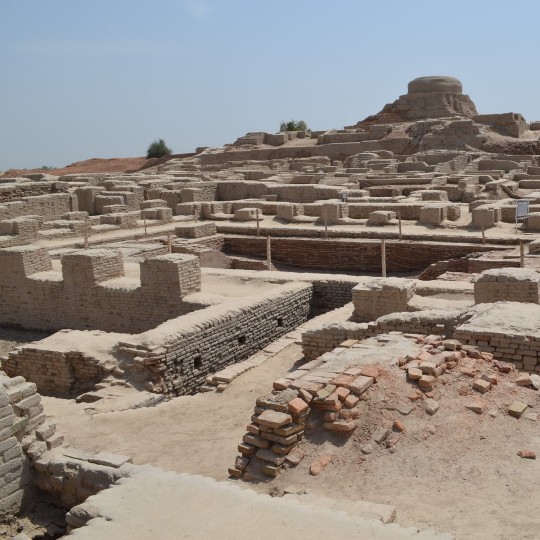
The Indus Valley Civilization was a cultural and political entity which flourished in the northern region of the Indian subcontinent between c. 7000 - c. 600 BCE. Its modern name derives from its location in the valley of the Indus River, but it is also commonly referred to as the Indus-Sarasvati Civilization and the Harrapan Civilization. These latter designations come from the Sarasvati River mentioned in Vedic sources, which flowed adjacent to the Indus River, and the ancient city of Harappa in the region, the first one found in the modern era. None of these names derive from any ancient texts because, although scholars generally believe the people of this civilization developed a writing system (known as Indus Script or Harappan Script) it has not yet been deciphered. All three designations are modern constructs, and nothing is definitively known of the origin, development, decline, and fall of the civilization. Even so, modern archaeology has established a probable chronology and periodization: Pre-Harappan – c. 7000 - c. 5500 BCE Early Harappan – c. 5500 - 2800 BCE Mature Harappan – c. 2800 - c. 1900 BCE Late Harappan – c. 1900 - c. 1500 BCE Post Harappan – c. 1500 - c. 600 BCE The Indus Valley Civilization is now often compared with the far more famous cultures of Egypt and Mesopotamia, but this is a fairly recent development. The discovery of Harappa in 1829 CE was the first indication that any such civilization existed in India, and by that time, Egyptian hieroglyphics had been deciphered, Egyptian and Mesopotamian sites excavated, and cuneiform would soon be translated by the scholar George Smith (l. 1840-1876 CE). Archaeological excavations of the Indus Valley Civilization, therefore, had a significantly late start comparatively, and it is now thought that many of the accomplishments and “firsts” attributed to Egypt and Mesopotamia may actually belong to the people of the Indus Valley Civilization. The two best-known excavated cities of this culture are Harappa and Mohenjo-daro (located in modern-day Pakistan), both of which are thought to have once had populations of between 40,000-50,000 people, which is stunning when one realizes that most ancient cities had on average 10,000 people living in them. The total population of the civilization is thought to have been upward of 5 million, and its territory stretched over 900 miles (1,500 km) along the banks of the Indus River and then in all directions outward. Indus Valley Civilization sites have been found near the border of Nepal, in Afghanistan, on the coasts of India, and around Delhi, to name only a few locations. Between c. 1900 - c. 1500 BCE, the civilization began to decline for unknown reasons. In the early 20th century CE, this was thought to have been caused by an invasion of light-skinned peoples from the north known as Aryans who conquered a dark-skinned people defined by Western scholars as Dravidians. This claim, known as the Aryan Invasion Theory, has been discredited. The Aryans – whose ethnicity is associated with the Iranian Persians – are now believed to have migrated to the region peacefully and blended their culture with that of the indigenous people while the term Dravidian is understood now to refer to anyone, of any ethnicity, who speaks one of the Dravidian languages. Why the Indus Valley Civilization declined and fell is unknown, but scholars believe it may have had to do with climate change, the drying up of the Sarasvati River, an alteration in the path of the monsoon which watered crops, overpopulation of the cities, a decline in trade with Egypt and Mesopotamia, or a combination of any of the above. In the present day, excavations continue at many of the sites found thus far and some future find may provide more information on the history and decline of the culture.
150 notes
·
View notes
Text
7 undeciphered writing systems
(While reading, remember that it’s possible to decipher a script and still not understand the language that the script represents.)
(Each heading links to that script's respective Wikipedia page.)
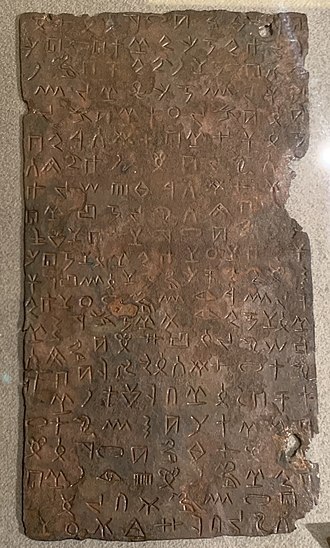
Byblos Syllabary
The Byblos syllabary is attested in 10 inscriptions found in Byblos, a coastal city in Lebanon. It likely represents a Semitic language, but despite a handful of attempts at decipherment, there still isn’t a consensus as to what sound each character represents.

Cypro-Minoan Syllabary
The Cypro-Minoan syllabary appears on ~250 objects—especially clay balls and cylinders that were used for recording economic transactions—on the island of Cyprus.
The script suddenly disappears in 950 BCE and was replaced by the Cypriot syllabary, which was used to write Greek, and based on Cypro-Minoan. This evolution allows us to infer the sounds of some of the signs in Cypro-Minoan, but we still don’t know what language it represented—probably either Minoan or Eteocypriot.
There are only ~2,500 total instances of signs for Cypro-Minoan, which is significantly less than Linear B when it was deciphered (~30,000).
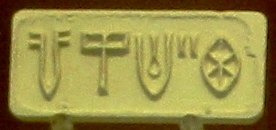
Indus Valley Script
The Indus Valley script is known from ~4,000 objects with very short inscriptions found in and around the Indus Valley, and represents the Harappan language (the unknown language of the Indus Valley civilization).
It has about 400 distinct signs, which is too many for each sign to represent a single sound or syllable, but too few for each sign to represent a word. Scholars thus think the system is logo-syllabic (basically a mix of the two).
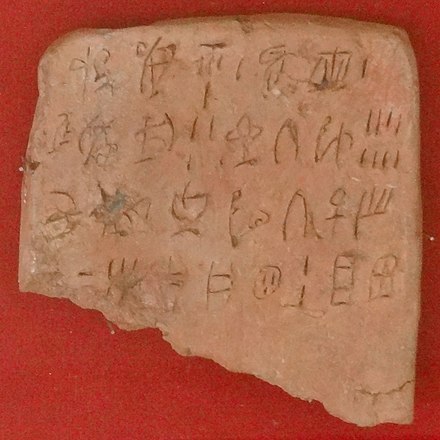
Linear A
Linear A: Everybody’s favorite mysterious undeciphered script. Linear A was used by the Minoans on the island of Crete, and is called “linear” because the script is written by cutting lines into clay, rather than pressing wedges into clay like cuneiform.
Linear A was adapted to write Mycenean Greek and became Linear B (deciphered in the 1950s), and because of this we can infer many of the sound values of symbols in Linear A. However, 80% of Linear A’s signs are unique, not shared with Linear B.
Linear A itself probably developed from the earlier Cretan hieroglyphs, which are also undeciphered.
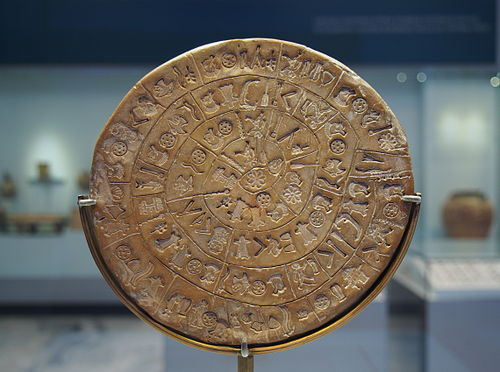

Phaistos Disk
The Phaistos Disk. Also from the Minoan civilization on Crete, yet seemingly unrelated to Linear A. This disk is the only certain attestation of this (assumed) script, spiraling around both sides. There are 242 tokens comprising 45 distinct signs.
The Phaistos Disk also happens to be an early example of moving type printing, since each character was made by pressing seals into clay.
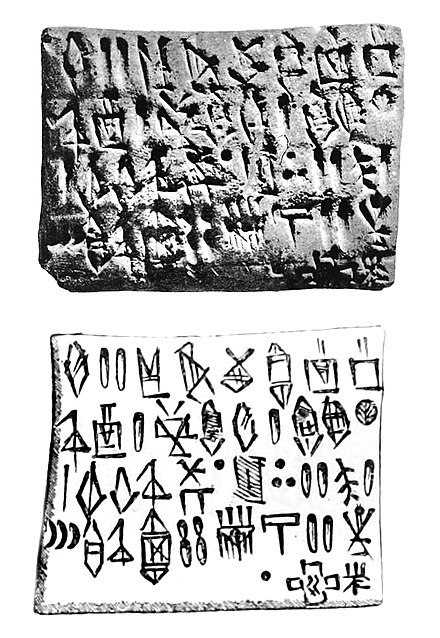
Proto-Elamite
The Proto-Elamite script developed alongside Proto-Cuneiform, and was used for similar functions and in similar ways until it was replaced by cuneiform. Proto-Elamite, like cuneiform, began as a system of marking tokens and spheres with details of economic transactions.
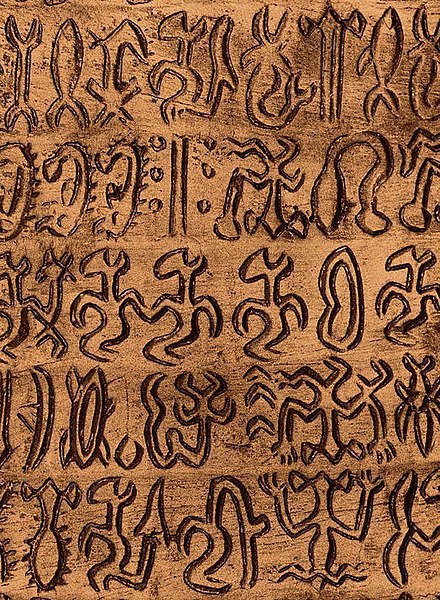
Rongorongo
Rongorongo is a system of glyphs used on Rapa Nui (Easter Island), found only on about two dozen wooden objects. According to oral history, the tablets were considered sacred, and only a small elite class could read them. Unfortunately, that tradition was wiped out after slaving raids and epidemics caused the collapse of Rapa Nui society.
Though the glyphs, if they are writing, undoubtedly represent the Rapa Nui language, little is known about it because modern Rapa Nui has had heavy influence from Tahitian.
---
Want to learn more about the world’s writing systems and their history? Check out my curated list of books on Writing & Writing Systems!
460 notes
·
View notes
Text

Here's my Indus Valley Civilization Miku, which I drew and posted a while ago but I deleted the post bc I was self conscious... Well it's back!
Details under the cut
The Indus Valley Civilization was a Bronze Age civilization in what is now Pakistan, northwestern India and parts of Afghanistan. They were pioneers of hydraulic engineering it seems. It lasted from around 3300 BC to sometime in the 2nd millenium BC.
The people of the IVC didn't leave behind as much figurative art as their Sumerian and ancient Egyptian contemporaries, at least that I could find. Nevertheless I tried to make a design based on what I saw on the internet.



The clothes and hairstyle are based on figures like these, they're often labeled as Mother Goddess statues but I guess we don't really know what they're meant to be.
The pattern and colors of the skirt are based on the famous "Priest King" statue (the name might be a bit of misnomer since from what I read, the IVC is though to have been fairly egalitarian). There was an attempt to reconstruct what the original colors might have been, which you can see in the thumbnail of this video... which I only found after finishing the drawing orz
youtube
The jewelry is based on the ones in images like these. You can see the design I used for the earrings too, I don't think the one pictured is an earring... but I thought it would look cool...

Etched carnelian beads like these were really hot back then apparently... people in IVC cities traded a lot with Sumerians because the Sumerians were crazy for these. In fact if you look closely at my Sumerian Miku you can see one such bead... well, it's a bit compressed.


Anyways... the Indus script has never been deciphered, so the text in the image is gibberish... but I added this cool bull from a stamp! I think it adds to the picture.
anyway that's it enjoy
#indus valley civilization#harappan civilization#hatsune miku#vocaloid#vocaloid fanart#miku worldwide#my art#stuff i made
42 notes
·
View notes
Text
Made Marion Development Update, August 2024

Official Will Route Release Window
I've checked in with the team and we aren't quite ready to release Will's route in (what remains of) the summer, but we're far enough that I have team buy-in on an official release window of the first half of October.
I'll have a more specific date once we begin our beta test in September, which usually lasts two weeks. I may release the first three chapters early for testers while I finish coding the chapters 4.
Will Chapter 3 will be fully written within a week from now. It turned out to be quite a beast. That means that Will's chapter 4s may be a bit shorter each than Robin's were, however, they will also be more different from each other than Robin's were. In fact, the love scenes and the climactic Chapter 4 action scenes are in completely different locations.

I'm going half-tilt on coding while I finish the script, and should have Chapter 1 fully coded soon, as well.
World Name Thoughts
Although the world in which Made Marion is set has three named countries: Avalon, Sunjata, and Nibiru, the world as a whole does not yet have a name.
I probably won't give it an in-universe name because its inhabitants primarily identify with their country of birth and don't really have a view of themselves as being on a planet in a system full of other planets. But still, since I'm planning to create multiple tales in this world (one for each country), I could use a name to call it for marketing purposes.
I've been putting this off for a while, but I'd like something with a historical/folkloric connection that deals with the number three OR that has something to say about the kingdom's themes - Sunjata, the Sun Lands; Avalon, the Middle Kingdom (light and shadow); and Nibiru, the Twilight Realm.
Right now I'm thinking perhaps "Triskelion," named after the Celtic triple spiral pattern. But I'm not 100% satisfied with that since I have two other countries that do not have Celtic inspiration (Sunjata is inspired by Medieval North and West Africa, while Nibiru is very loosely inspired by Ancient Babylon and the Indus Valley Civilization). It's probably not a big deal since it'd be difficult to encompass all three and this entire world began with my desire to thread Celtic elements into the Robin Hood tales, but still. Any thoughts or ideas?
Here's a reward for everyone who made it to the end. Arrapso didn't make those shirtless combat sprites for nothing!
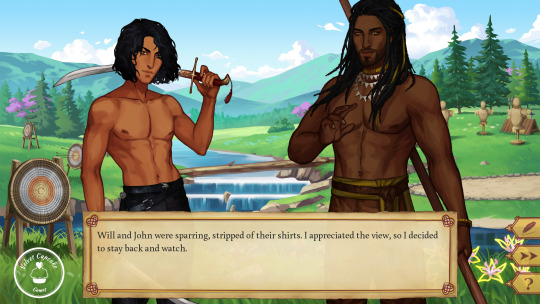
42 notes
·
View notes
Note
Hello dear Gia
May I please receive more facts about the Indus Valley Civilization <3
(and good luck with your studying)
HI YES ALWAYS (thank you!!!)
okay so here are some things we know about the indus valley civilization’s script:
it’s not alphabetical, because there are a bit too many symbols for that (375-400) (so far)
it was written from right to left. we’ve extrapolated this from the fact that the spacing on the right is usually more even than the left
it was EVERYWHERE: on the lids of jars, on seals, on beads, we’ve even found a sign board?? this could imply that literacy was widespread (reminder that this is about. ~5000 years ago. yeah)
now here’s what we don’t know about the script:
what any of it actually fucking says
there is a HUGE dearth of information on so many facts of ordinary harappan life (things like did they have religion? rulers? gender?) and a part of this is definitely attributable to the fact that we can’t for the life of us decipher their script. it’s infuriating. you’d think maybe the mesopotamians could help with that, but no. they just don’t give a shit. and honestly even if we could decipher it there’s no telling if it’ll actually give us any information because these people were advanced enough to have some old biodegradable paper-esque thing where they actually wrote stuff (as opposed to, like, clay. like in mesopotamia) which was great for them but NOT for us because it, well, biodegraded. basically our best hope rn is that some inscription with the harappan script AND another script will turn up
#mundane <3#thank you for the ask!!#indus valley#harappan civilization#harappa#indus valley civilization#history#language
12 notes
·
View notes
Text
Translating the Harappan Script
Translating the Indus Valley script remains a formidable challenge, primarily because it has not been definitively deciphered yet. Scholars are still working on various hypotheses and approaches, but no one has succeeded in providing a definitive translation. However, there are several methods and steps that researchers follow to try and make sense of the script:
1. Collect and Catalog Inscriptions
The first step is gathering and cataloging all the known inscriptions of the Indus Valley script. This includes texts found on seals, pottery, tablets, and other artifacts. Researchers try to identify recurring patterns and symbols in these inscriptions, which might represent words, phrases, or concepts.
2. Identify and Classify Symbols
The Indus script contains hundreds of unique symbols. These symbols are thought to represent:
Pictograms: Images or symbols that may represent objects or ideas.
Phonetic signs: Symbols that may represent sounds or syllables (like in a syllabary or alphabet).
Ideograms: Symbols representing ideas or concepts.
Researchers try to classify these symbols, determine how they might be used in different contexts, and look for patterns in their usage (e.g., recurring symbols or clusters of symbols).
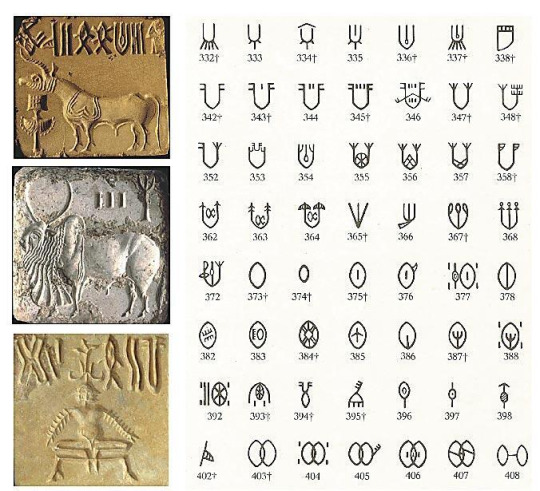
3. Look for Repetitive Patterns
The most promising approach to deciphering the script is recognizing recurring sequences. If certain symbols appear frequently or together, they might represent common words or grammatical structures. For instance, some symbols consistently appear together on seals, suggesting they might represent a name or title. Identifying such repeated patterns is a major part of the effort to decode the script.
4. Hypothesize About Phonetic Values
Since there’s no known Rosetta Stone to directly link the Indus script to a known language, some researchers hypothesize that the script might represent sounds (like the alphabetic systems) or syllables (like the syllabaries). They analyze the way symbols are combined and try to propose phonetic values for certain characters. This step is speculative, but it's a vital area of research.
5. Compare with Known Languages
Some scholars attempt to compare the Indus script with the known languages of the region. The two main hypotheses are:
Dravidian Hypothesis: Some suggest that the language might be related to the Dravidian languages spoken in southern India. However, no clear connections have been established.
Austroasiatic or Indo-European Hypothesis: There are also theories suggesting that the language could be related to other language families, though these ideas have not gained broad acceptance.
Comparing the script with related languages is difficult, though, as no direct linguistic evidence exists to link the Indus Valley script with any language family.

6. Use Computational Tools
Modern computational techniques, such as statistical analysis and pattern recognition, are being used to analyze the script. Researchers create algorithms to look for statistical patterns in the frequency and combinations of symbols, attempting to uncover hidden linguistic structures. These approaches are still in early stages, but they could provide a breakthrough in understanding the structure of the script.
7. Look for Contextual Clues
Context is essential in understanding any written language. Researchers study the locations and types of objects the inscriptions are found on. For example, most Indus script inscriptions are found on seals used for trade, which could suggest that the script was primarily used for administrative or commercial purposes. Looking at the context of the inscriptions might provide clues about their meaning.
8. Consider the Social and Cultural Context
Finally, understanding the social, cultural, and historical context of the Indus Valley civilization is crucial. The script was likely used to convey information about trade, religion, administration, and possibly mythology. Knowledge of the civilization’s practices, beliefs, and economy could provide additional insights into what the script might represent.
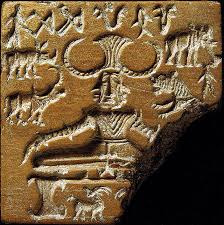
Pashupati Seal
Challenges and Current Status
No Bilingual Inscriptions: Unlike Egyptian hieroglyphs, there are no known bilingual inscriptions that could act as a “key” to the script.
Fragmentary Data: Most inscriptions are very short, often only a few characters long, making it difficult to gather enough context to understand their meaning.
Multiple Interpretations: There are various competing theories about the nature of the script, its language, and its function. The lack of consensus on these fundamental issues complicates efforts at translation.
Conclusion
Despite these efforts, translating the Indus script remains a work in progress. While various researchers have proposed partial solutions or interpretations, none of them have been universally accepted. As new data and computational tools emerge, it’s possible that scholars might come closer to deciphering the script, but for now, it remains one of the great mysteries of ancient writing systems.

#history#archaeology#indian history#indian#indus valley#culture#museum#scripture#epigraph#linguistics#inscription
15 notes
·
View notes
Text
Ze End of Ze Bronze Age
Hokay. So here’s the Near East. Just chilling. Dayumn, that is a nice Near East you might say. WRONG. Ruling out the Persian Gulf sinking, earthquakes and solar eclipses, Egypt’s brief fling with monotheism killing the gods, and the invention of iron smelting, we're definitely going to blow ourselves up. hOKAY. So Basically, we’ve got the Mycenaeans, the Kassites, the Assyrian Empire, the Hittites, the Egyptian New Kingdom, Ugarit, Canaan, the Sea-Peoples, the Amorites, the Luwians, and Us (the Babylonians). With Bronze. Ok so one day the Sea-Peoples are like “those Egyptian sons of a bitches are goin’ down.” So they launch themselves at Egypt. While it’s on the way Ramses II is like “SHIT SHIT WHO THE FUCK IS INVADING US. Oh well. Fire arrows!” Canaan is like “shit guyz’ … Ze sea peoplez are coming! Fire arrows!” “But I’m v’tired!” “Oh well have a nap… BUT ZEN, FIRE ZE ARROWS!” The Indus Valley is like “WTF mates?” The Assyrians, Ugarit and the Amorites launch THEIR shit, so now we’ve got arrows literally passing each other in mid-air (‘Yo. ‘Sup). Hittites are like AAAAAAH HANNAHANNA! “The Myceneaans are like “‘bout that time eh chaps? Right oh!” The Assyrians are like “fuck we’re dumbasses.” The Luwians are like “what’s going on, eh?” The Indus Valley is still like “WTF mate?” Mars is laughing at us, and some huge meteor’s like “well, fuck that”. So, now there's a dark ages, (Yes!!) and everyone's dead.... (...No, wait) Except the Indus Valley.... And they're still like, WTF? But they'll be indecipherable soon. Fucking indus script…Buuuuut! Asuming we don't blow ourselves up, us Mesopotamians have to work our way of breaking off the continent (bypass DOOM) to go and hang with the Land of Magan....
The Indus valley can come too.
ZE END.
34 notes
·
View notes
Text
The Salado Phenomenon is what I’m writing my thesis on right now haha. The Wikipedia page for it sucks, don’t look at that. I need to do an overhaul of it one of these days
29 notes
·
View notes
Note
hi. i heard there were ancient drainage systems
LETS. GOOOOO
Okay so, the ancient civilization (and by extension, its infrastructure) is by FAR the Indus River Valley Civilization.
A bit of background because, while it is on of three first major civilizations (the other two being Egypt and Mesopotamia), it is far more obscure. This is can likely be ascribed to the fact that a) we know much less about it (since we can't read their written language (and even if we could, the script survives mostly in the form of short inscriptions)) and b) western scholars only discovered it in the late 1800's. It's a very, very vast civilization spread over parts of both Pakistan and India.
But anyway, the drainage systems. So, the Indus people are known for having extremely advanced infrastructure for their time, like, advanced to the point of being rival to that of ancient Rome. Cities were built on a grid pattern (think NYC). Streets had standardized widths.
But notably, the Indus people had sewers. Not only that, but some homes even had flush toilets. Every home had a bathroom with piping connecting to drains in the street. Fertile wastewater would eventually be deposited in agricultural fields on the outskirts of the city. THEY HAD SEWERS. THEY HAD FLUSH TOILETS. ITS INSANE.
Oh, and remember how I mentioned that the Indus civilization was contemporary to ancient Egypt and Mesopotamia? Their drainage systems are (obviously) also old as fuck. In fact, their water drainage system is one of, if not the, oldest in the WORLD. And certainly the most sophisticated of the ancient world.
tbh I think what makes drainage systems so fascinating to me is how, like.....how much they showcase just how advanced ancient people really were. Idk it's just something about it
#i realize this is kind of not a lot about actual drainage systems#i jsut realized that the Indus civilization's system is the one I know most about and feel most comfortable sharing about#because of the fact that I know so much about it and know that my info is from reliable sources that i got from an actual college professor#lol#anyway THANK YOU GUMYYYY. i could actually go on so much about the IRVC lol#asks#i speak#friend tag :]#ancient history
4 notes
·
View notes
Text
Reading and Literacy
Reading is as old as writing, beginning about 3500 BCE in Sumer with the development of writing. This led to the development of the scribal class and the concept of literacy and functional literacy as well as illiteracy and functional illiteracy. Exactly who could read and they read changed through history.
Literacy is, in its simplest form, the ability in adults to read, but it can be divided into at least four categories. Someone is considered fully literate if they can read, write, and understand, use, engage with, and evaluate written texts. Functional literacy is when someone is able to function in society, but they do so at with less ease or at a lower level than those who are fully literate or they choose not to engage with written works in more depth. Someone is functionally illiterate, they have trouble functioning in their society due to a lack of ability to read or write despite education. Illiteracy is generally a term related to those who are unable to read or write at all, though not through disability or lack of education. Literacy is independent of IQ, so someone can be highly intelligent but also illiterate in some form.
Writing developed in at least five civilizations throughout history, Sumer, Egypt, the Indus River Valley Civilization, the Zapotec and Olmec, and Shang Dynasty China. Sumer is the first civilization that we know of to develop writing around 3500 BCE. The degree of literacy in each civilization varies and is sometimes quite difficult to ascertain in the records we have.

By Unknown author - Marie-Lan Nguyen (2009), CC BY 2.5, https://commons.wikimedia.org/w/index.php?curid=6019215
Among the Sumerians, literacy was a matter of necessity related to bureaucracy. The writing system began as a form of accounting and expanding from there into recording oral stories and daily records and then into correspondence. Among assyriologists, those who study the vast cuneiform records, it is believed that functional literacy was 'somewhat widespread by the Old Babylonian period', though scribes were likely the only class of people who were fully literate.

By This font is developed by Mr. Shabir Kumbhar, engineering / embedded and mapping by Mr. Amar Fayaz Buriro with the consultation of Dr. Kaleemullah Lashari and Mr. Manzoor Ahmed Kanasro (DG Antiquities & Archaeology, Government of Sindh). - http://mohenjodaroonline.net/index.php/indus-script/corpus-by-asko-parpola, CC BY-SA 4.0, https://commons.wikimedia.org/w/index.php?curid=114524179
The Indus Valley Script emerged around 3500 BCE as well, but given many of the inscriptions we have now are very short, we don't know if it was a full writing system and we haven't been able to decipher it yet. Because of this, we also don't know what writing was used for nor how literate the population was.

By Author of the photograph: W M Flinders Petrie (3 June 1853 – 28 July 1942) - Egyptian Civilization: Its Sumerian Origin and Real Chronology (1930)Published 1930, Public Domain, https://commons.wikimedia.org/w/index.php?curid=77734127
Among the Ancient Egyptian people, writing and literacy emerged around 3300 BCE and is thought to extend to between 1-15% of the population, depending on the time period, though the evidence for this is limited due to the fragility of the papyrus record compared to the clay record that the Sumerians left behind.

By Late Shang inscription (period III, c. 1170 BCE – c. 1147 BCE) - Figure I.5, Public Domain, https://commons.wikimedia.org/w/index.php?curid=140788990
In China, writing developed in the Shang Dynasty, around 1200 BCE. These appear to begin with accounting among the elite, recording sacrifices, tributes, and hunting. Writing evolved to form and police the hierarchical bureaucratically government during the Qin and Han dynasties (around 200 BCE). by the Zhou dynasty, education was deemed important to the imperial government and thus became important to the lower classes as an effort to either move up or emulate the upper classes and was recorded in the Book of Rites (Liji 禮記), which became one of the Five Classics and schools were widespread during the Autumn and Spring periods. Understanding of literacy in this period is still being studied, though, as recent discoveries have changed previous thinking as to how and by whom written works were used.

By Sorry, I dont understand the original text in japanse - Japanese wikipedia: w:ja:画像:Tres Zapotes Stela.C.back.Pt1.JPG, Public Domain, https://commons.wikimedia.org/w/index.php?curid=715642
The Olmec and Zopotec peoples developed glyphic writing sometime between 900-400 BCE. The writings that we have remaining seem to be related to royal and calendar uses. Most of the writing we have remaining is inscriptions in stone, so it's difficult to figure out how literate the civilizations were.

By unknown - William Foxwell Albright, The Proto-Sinaitic Inscriptions and Their Decipherment, Public Domain, https://en.wikipedia.org/w/index.php?curid=34607419
The development of alphabetic scripts, in which a single symbol represented a single sound, is contested. Some hold that the Ancient Greeks developed the first system in 750 BCE. Others contest that the ancient Semetic-speaking people of Canaan developed a consonantal alphabet system, in which a single symbol represented a single consonant sound, around 1500 BCE. This consonantal system then developed into the writing of the Phoenician, Hebrew, and Aramaic peoples. In these systems, there were initially 30 cuneiform symbols to represent the consonants. Previous thinking had the Greeks influenced by the Phoenicians in developing a full alphabet with vowels, but more modern research points to the Greeks being influenced by the Canaanite people with influencing the Greeks. The simplification of the writing systems allowed them to spread much further than the empires that used them. Emerging research suggests that literacy was more widespread than previously thought and those rates are being revised, but the literacy of soldiers, based on what appear to be letters home that have been recently recovered, as early as the 7th century BCE point to a much higher rate than previously thought.
As with literacy rates in previous eras, the literacy rates in antiquity (among the Classical Greek and Roman societies) is under revision due to more recent discoveries leading to reinterpretations of previous evidence, but it does seem to be more widespread than previously thought (that being only among the elite or a particular class of scribes and priests). Anthony DiRenzo stated in a 2000 article in the Journal fo Technical Writing and Communication that Roman society was 'a civilization based on the book and the register' and that 'no one, either free or slave, could afford to be illiterate'. This is under contention and still being studied.
6 notes
·
View notes
Text
Submitted via Google Form:
What is the earliest point in evolution could humans evolve written language? Let's say biologically, human evolution was similar to reality, could say Neanderthals have written language already? Like before civilisations began? Also, written language is certainly not only for the elite. In fact, it got started in various families and then got spread among the tribes. So we have thousands of different tribes and familes across the world - each with their own languages and writing systems. Of course, there are some similarities as people have travelled a bit and met neighbouring tribes. So basically before society was properly formed into civilisations, there should already be writing but civilisation is actually what prodded society to centralise communications and languages. Does this work? Basically, I just want a society that had writing from much earlier on than reality and figuring out how it could have been done.
Tex: Writing is developed, much like any other tool, as a function of necessity. If it’s not necessary for a society to develop it, then writing won’t exist for them. Civilisation is also, as a concept, prone to periodic re-defining as we accumulate more data and our perceptions of the data shift (for example, one could define the pinnacle of civilisation as taxes, where before another defined it as religion). Writing also has exceptionally little to do with biology as writing is a social construct meant to fill a void found in one’s culture. Consequentially, writing can also encompass a broad range of intentional markings that demonstrate specific meanings, from tally marks, to standardized pictures, to ideograms, to glyphs. What does your world need writing for? What niche does it fill? What were the people using as its predecessor, and what happened to cause them to change systems? Did the scope of their needs change, or did the perception of their needs change? What information is important for them to record, on a societal and personal level? Who teaches writing? Who learns it? What is the method of transmission, and for those that teach writing, is it their sole occupation or something on the side?
Utuabzu: Writing is old. Really old. At least 5000 years old. This seems a long time, but humans have been living in permanent settlements and practicing forms of agriculture in West Asia for about 9000 years. Homo sapiens has been around for at least 300,000 years. But only in the last few thousand years, in a handful of places, did humans independently come up with the idea that the spoken word could be preserved using symbols that others could be trained to decipher.
The earliest writing as far as we can tell is cuneiform, from Sumeria in what is now southern Iraq. It may or may not have had some influence on the development of Egyptian hieroglyphs from pictographs to an actual script - we have found Sumerian cylinder seals in very early Egyptian sites, indicating that the two groups were in contact. But from these two points the idea of writing spread through the Mediterranean and West Asia. The Indus Valley civilisation also used a script, but we are unable to decipher it and have relatively few examples to work from, so we cannot tell if it even is a true script or if it predates contact with Sumeria.*
Shang Dynasty China also developed the earliest form of Chinese script from the Oracle Bone tradition not long after this. This also spread, together with Chinese ideas, agricultural and governmental practices across much of eastern Asia.
Meanwhile cuneiform script was adopted by a wide range of cultures in West Asia, and inspired other scripts like Elamite, Old Persian and Ugaritic, which while using similar shapes were structured very differently. Egyptian hieroglyphs inspired Anatolian hieroglyphs and were later in the early Iron Age the basis that the Phoenician alphabet** - ancestor of alphabetic, abjad and abugida scripts from the Philippines to Iceland - was derived from.
Another place we see writing develop entirely independently is in Central America, where a pictographic system was employed from the Olmec period all the way through to the 16th Century, but only became a true script in the Mayan region [at time, need to check when]. The system employed elsewhere in Mesoamerica did not have the capacity to accurately render speech, so far as we are aware.***
There are also a handful of other instances that might or might not be examples of true scripts developing entirely independently, from rorotongo on Rapanui to the quipus of the Andes to [pretty sure there's one in central africa, but can't remember the name just now]. We simply don't have enough information to be certain about any of them. Oftentimes, because the media they were written on does not survive all that well, or was deliberately destroyed.
But something you should bear in mind is that complex societies don't necessarily require writing for a lot of their history. Many of the most impressive cultures of the ancient world were not widely or at all literate. There's no indication that the Mississippian culture that built sites like Cahokia had writing, nor did Teotihuacán or the various cultures of the Andes. There's no evidence of writing at Great Zimbabwe, nor at Jomon sites in Japan.
Even in cultures that did have writing, it was frequently not a widely known skill. Your average ancient Egyptian couldn't read hieroglyphs, and Chinese hanzi still take years to master. This is part of why so many traditional scripts were displaced in the 19th and early 20th century. Most people couldn't read them and when authorities decided to use Roman or Cyrillic or something else in mass education, it very quickly became much more widely understood than the traditional script.
To my knowledge, there's no examples of a pre-agricultural society developing writing independently. Some have derived scripts from those they came into contact with, or made entirely unique ones inspired by writing they knew of. But so far as I am aware, none have ever created a script entirely from scratch with no prior exposure to the concept of writing.
*the Sumerians appear to have called the Indus Valley Civilisation 'Meluhha', and were actively trading with it from at least the Bronze Age. Ur III records even tell of a colony of Meluhha merchants at Guabba, near Lagaš, and Sumerian cylinder seals have been found in Indus Valley sites.
**actually an abjad.
*** the conquistadors burned almost all pre Columbian codices, so we can't ever be 100% certain that no other variants of the system developed into true scripts. But it's unlikely.
25 notes
·
View notes
Photo

Ancient Secrets
Imagine an ancient civilization that rivaled Egypt and Mesopotamia in sophistication but remains a mystery to this day. The Indus Valley Civilization was a fascinating culture that thrived between 7000 and 600 BCE in the Indian subcontinent. Its cities like Harappa and Mohenjo-Daro hosted large populations, suggesting a highly developed urban society. Yet, despite its impressive accomplishments, the civilization's writing system remains undeciphered, leaving many secrets untold.
Introduction
The Indus Valley Civilization, spanning over 900 miles, was a cultural and political powerhouse. Its cities were significantly larger than most ancient urban centers, with populations reaching between 40,000 to 50,000 people.
Key Facts
Periodization:
Pre-Harappan (c. 7000 - 5500 BCE)
Early Harappan (c. 5500 - 2800 BCE)
Mature Harappan (c. 2800 - 1900 BCE)
Late Harappan (c. 1900 - 1500 BCE)
Post Harappan (c. 1500 - 600 BCE)
Located in the Indian subcontinent, with sites found as far as Afghanistan and Nepal.
Cities: Harappa and Mohenjo-Daro were major urban centers.
Population: Estimated 5 million people.
The Indus Valley Script remains undeciphered.
Historical Context
The Indus Valley Civilization was discovered relatively late compared to others like Egypt and Mesopotamia. This delayed discovery has led to the realization that some historical "firsts" attributed to these civilizations might actually belong to the Indus Valley people.
Historical Significance
The civilization's sophisticated urban planning and large population sizes highlight its advanced societal structure. The civilization's achievements suggest that it may have been a pioneer in various aspects of ancient culture.
Why You Should Know About It Today
Understanding the Indus Valley Civilization provides insights into the early development of human societies and challenges common historical narratives about the origins of civilization. Its mysterious script continues to fascinate scholars and the public alike, promising new discoveries in the future.
60 notes
·
View notes